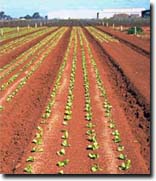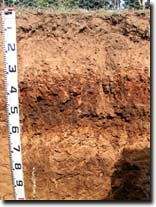Victorian State Soil Contender - Red Sodosol

Back to: Contenders for State Soil
Why should the Red Sodosol be Victoria’s State Soil?
- Victoria has a greater proportion of Sodosols than any other state. It is quite possible that Sodosols may not be selected as the State Soil for another state – and as Sodosols are a very widespread soil in Australia it would be fitting if one was nominated as a State Soil by Victoria.
- Red Sodosols are widespread throughout much of Victoria and are common in mid to low rainfall areas of the state - particularly in the Wimmera plains, parts of the Mallee, North Central, Goulburn Broken and western Port Phillip and Westernport regions.
- These soils are important cropping soils in Victoria. They support dryland cropping (mainly cereals) in the Wimmera region. In other parts of the state, they are important irrigation soils supporting high value irrigated pasture, orchards and vegetable cropping on the northern plains (especially Shepparton Irrigation region), as well as high value irrigated vegetable production (e.g. lettuce) in the Werribee region.
Any reasons why this soil should not be Victoria’s State Soil?
|  Red Sodosols are major cropping soils in the Werribee region. |
Typical soil profile
| This example Red Sodosol occurs in the Werribee area. It has formed on alluvial deposits of older streams (prior streams) that traversed this region in wetter climate periods. Some windblown (aeolian) material has also been incorporated. |  Red Sodosol near Werribee | ||
| Surface Soil | |||
| A1 | 0-12 cm | Brown; fine sandy loam; moderately acid pH. | |
| A2 | 12-30 cm | Brown; fine sandy clay loam; neutral pH; abrupt change to: | |
| Subsoil | |||
| B21 | 30-60 cm | Dark red; medium clay; coarse prismatic structure, parting to coarse blocky structure; slightly alkaline pH. | |
| B22 | 60-75 cm | Strong brown; light clay (fine sandy). | |
| B23 | 75-100 cm | Brown; light clay (fine sandy); contains small amounts of carbonate (lime); moderately alkaline pH. | |
Other examples of Red Sodosols on the Victorian Resources Online website
Red Sodosol in an orchard at East Shepparton
Red Sodosol in cereal cropping area north of Birchip in the Mallee region
Red Sodosol near St Arnaud in the North Central region
Red Sodosol in the Werribee region


